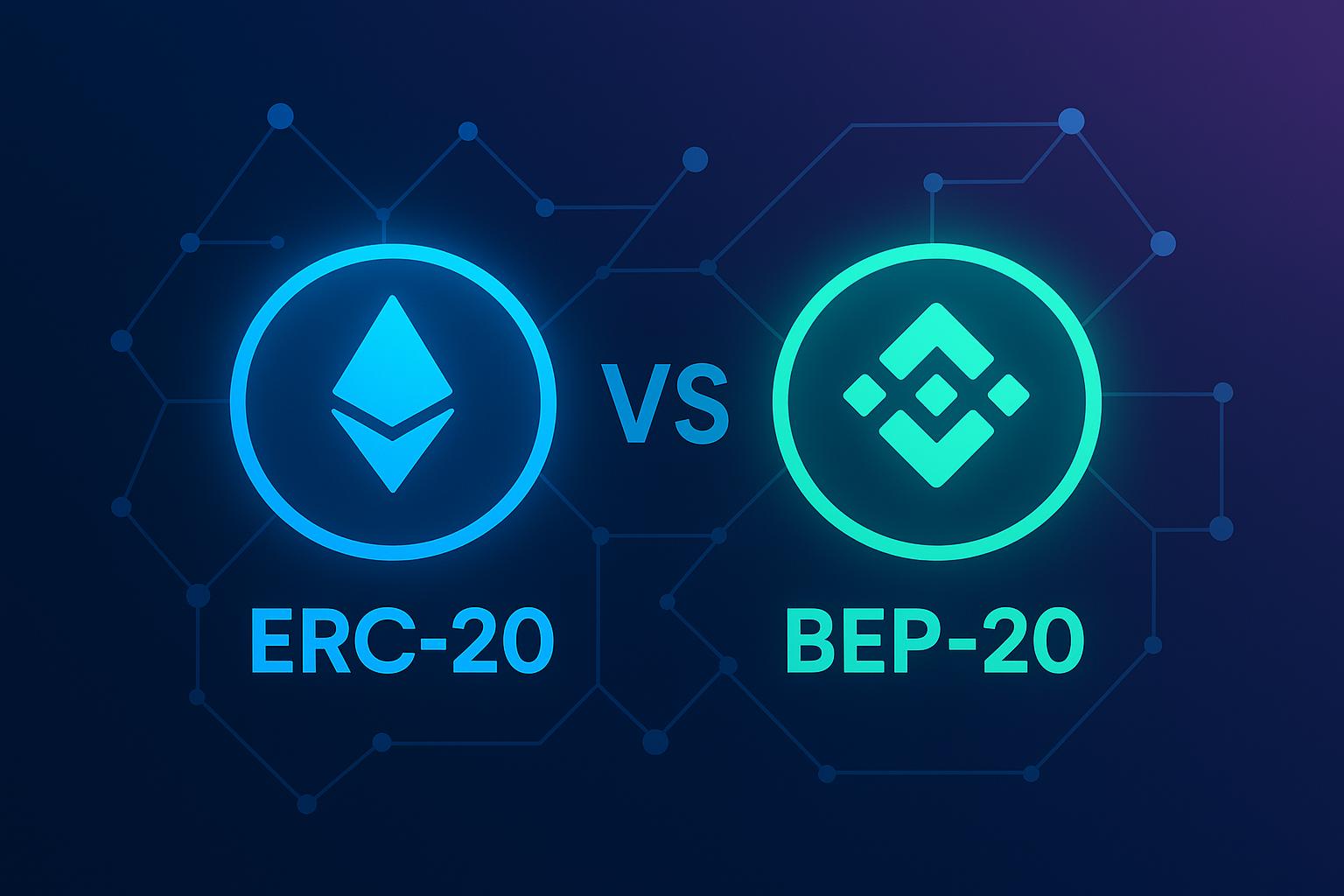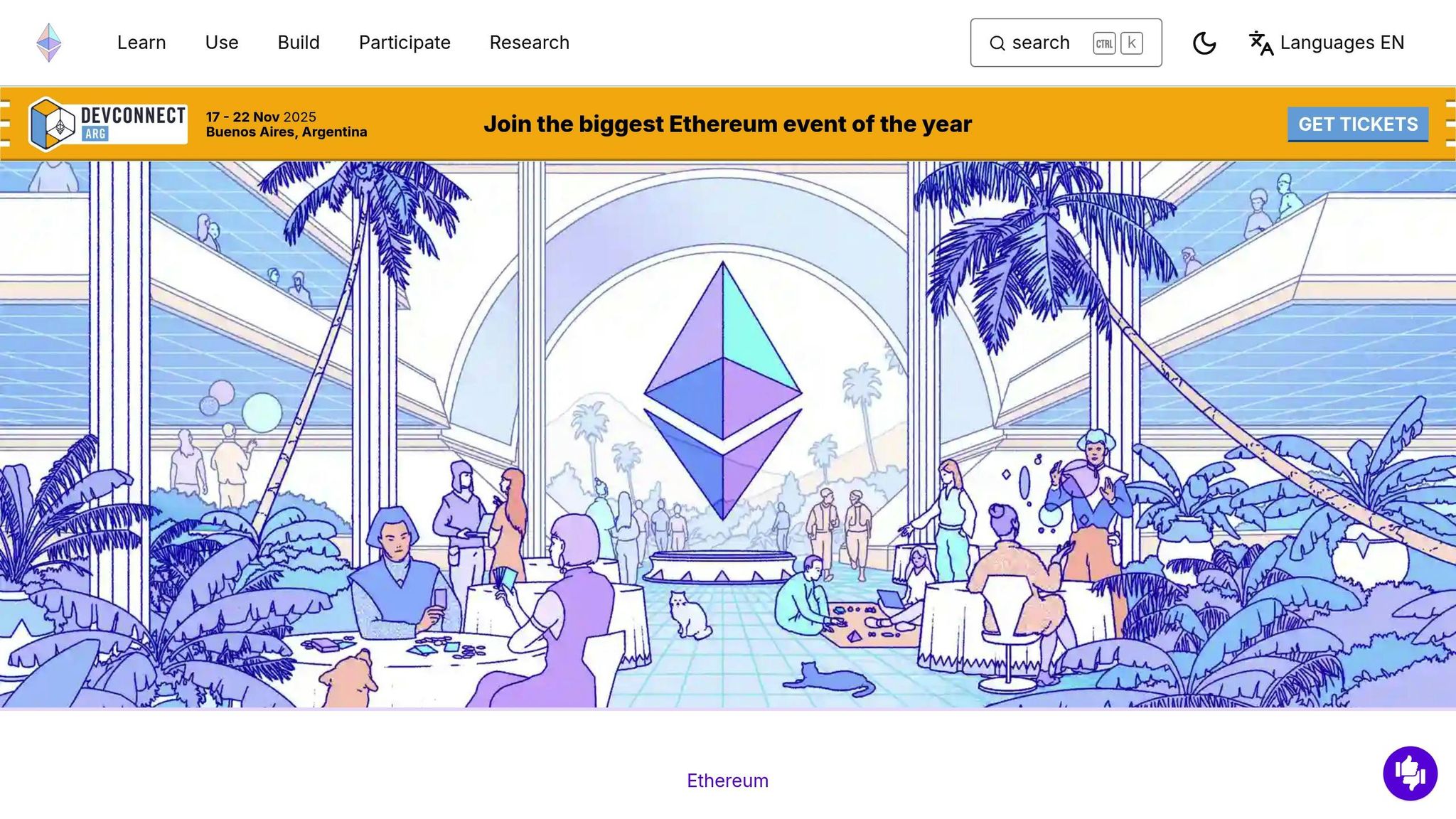ERC-20 vs BEP-20: Key Differences
Explore the differences between ERC-20 and BEP-20 tokens, from transaction speed and costs to security and ecosystem support.

When comparing ERC-20 and BEP-20 tokens, the key differences come down to the blockchain they operate on, transaction speed, costs, and security. ERC-20 tokens run on Ethereum, offering strong decentralization and security but with slower transactions (15 seconds) and higher fees (often over $10 during congestion). BEP-20 tokens, built on Binance Smart Chain (BSC), prioritize speed (3-second transactions) and low fees (a few cents) but are more centralized with only 21 validators.
Quick Overview:
- ERC-20: Built on Ethereum, high security, slower transactions, higher fees.
- BEP-20: Operates on Binance Smart Chain, faster transactions, lower fees, less decentralized.
| Feature | ERC-20 (Ethereum) | BEP-20 (Binance Smart Chain) |
|---|---|---|
| Transaction Speed | ~15 seconds | ~3 seconds |
| Fees | Higher (ETH gas fees) | Lower (BNB fees) |
| Validators | 400,000+ (decentralized) | 21 (more centralized) |
| Best For | Security, DeFi projects | Low-cost, fast transactions |
ERC-20 is ideal for projects needing high security and access to Ethereum's ecosystem. BEP-20 suits those prioritizing fast, affordable transactions. Always check network compatibility to avoid losing funds when transferring tokens.
Blockchain Networks and Ecosystems
ERC-20: The Ethereum Network

The Ethereum network underpins ERC-20 tokens, providing a decentralized and open-source blockchain widely recognized for its smart contract capabilities. With over 400,000 Proof of Stake validators securing the network, Ethereum offers a high level of security and decentralization.
Ethereum's ecosystem showcases its maturity and reliability. Blocks are processed approximately every 15 seconds, and the Ethereum Virtual Machine (EVM) has paved the way for thousands of decentralized applications (dApps). Leading DeFi platforms like Uniswap, Aave, and MakerDAO have chosen Ethereum as their foundation, reflecting its adoption and trustworthiness.
A thriving developer community ensures ongoing advancements, making ERC-20 tokens compatible with a wide range of wallets, exchanges, and dApps. While Ethereum emphasizes decentralization and security, other networks focus on different priorities.
BEP-20: The Binance Smart Chain Network

Binance Smart Chain (BSC), on the other hand, prioritizes speed and affordability. Designed as a fast and cost-effective blockchain, BSC complements Binance's broader ecosystem. It uses a Proof of Staked Authority (PoSA) consensus mechanism, with only 21 validators, allowing for quicker transaction processing.
This streamlined model enables BSC to achieve block times of about 3 seconds, a significant improvement over Ethereum's 15-second blocks. However, this comes with a trade-off: fewer validators mean BSC operates with a more centralized structure compared to Ethereum's decentralized approach.
PancakeSwap is a standout example of BSC's appeal, offering decentralized exchange services similar to Ethereum-based platforms but with lower fees and faster transactions. Despite its efficiency, BSC's reduced validator count has raised concerns about potential security risks. While Ethereum focuses on decentralization, BSC leans into speed and cost-effectiveness.
Wallet Support and Network Setup
Understanding the distinctions between these networks is crucial for managing ERC-20 and BEP-20 tokens safely. Though both use an Ethereum-style address format, they are not interchangeable across networks. Despite the similar format, attempting to transfer tokens between these networks without proper configuration can lead to errors.
Popular wallets like MetaMask, Trust Wallet, and Ledger support both ERC-20 and BEP-20 tokens. However, users must manually configure network details to avoid cross-network transfer mistakes. For example, MetaMask users need to add Binance Smart Chain's specific RPC endpoints and chain IDs to access BEP-20 tokens.
One significant risk is cross-network transfers. Sending ERC-20 tokens to a BEP-20 address - or vice versa - results in a permanent loss of funds. To prevent such errors, users should always verify the correct network is selected before initiating any transaction. While wallet interfaces often display the active network prominently, the responsibility ultimately lies with the user to double-check.
When deciding between Ethereum and Binance Smart Chain, consider your priorities. Ethereum offers robust security and a well-established ecosystem but can have higher fees during busy periods. BSC, by contrast, provides faster transactions and lower costs but sacrifices some decentralization. Choose a wallet that clearly distinguishes between networks and makes switching straightforward to avoid costly errors. Understanding these network and wallet differences is essential for managing ERC-20 and BEP-20 tokens effectively.
Technical Features and Performance
Core Functions and Features
ERC-20 tokens come with standard functions like totalSupply, balanceOf, transfer, transferFrom, approve, and allowance. BEP-20 tokens, on the other hand, introduce additional features such as minting, burning, pausing, and blacklisting, which provide more tools for managing token supply and ensuring security.
These extra capabilities give BEP-20 tokens an edge when it comes to control. For example, if a security issue arises, BEP-20 token issuers can immediately pause all transactions to contain the problem. Achieving the same with ERC-20 tokens often requires more complicated solutions. This enhanced functionality makes BEP-20 tokens particularly appealing for projects that demand active token management or compliance measures. These fundamental differences set the stage for the performance comparisons outlined below.
Transaction Speed and Costs
When it comes to transaction speed, ERC-20 tokens take about 15 seconds for confirmation, while BEP-20 tokens average just 3 seconds. This speed difference reflects the underlying blockchain designs - Ethereum's network tends to be slower and more expensive, whereas Binance Smart Chain (BSC) is optimized for faster, more cost-efficient transactions.
This distinction is crucial for applications like high-frequency trading, gaming, or real-time transactions, where even small delays can disrupt user experience or trading opportunities.
The cost structure further highlights the differences. ERC-20 transactions, paid in ETH, often see fees spike during network congestion. BEP-20 transactions, paid in BNB, benefit from lower fees and higher throughput, making them a better fit for frequent transactions or micro-payments where high costs could be a dealbreaker.
| Feature | ERC-20 (Ethereum) | BEP-20 (Binance Smart Chain) |
|---|---|---|
| Transaction Speed | ~15 seconds | ~3 seconds |
| Fee Structure | Higher (ETH gas fees) | Lower (BNB fees) |
| Impact of Congestion | High during peak times | Minimal due to higher throughput |
Security and Network Control
Security is another area where ERC-20 and BEP-20 tokens diverge, largely due to differences in their blockchain architectures. ERC-20 tokens benefit from Ethereum's highly decentralized Proof of Stake (PoS) model, supported by over 400,000 validators. This decentralization makes Ethereum more resistant to attacks and censorship.
BEP-20 tokens, however, operate on Binance Smart Chain's Proof of Staked Authority (PoSA) model, which uses just 21 validators. While this setup enables faster transactions and lower costs, it also creates a more centralized network that may be more susceptible to coordinated attacks or censorship.
The additional management tools in BEP-20 tokens - like pausing transactions or blacklisting - enhance security responses but come with a trade-off: increased centralization.
Ultimately, ERC-20 tokens align better with decentralization and security-first principles, making them a go-to choice for projects that prioritize these values. Meanwhile, BEP-20 tokens cater to projects that value flexibility, faster performance, and practical security tools, even if it means sacrificing some decentralization.
Real-World Applications and Market Adoption
Common Uses for ERC-20 and BEP-20 Tokens
ERC-20 has become the backbone of decentralized finance (DeFi), hosting over 80% of DeFi projects on the Ethereum network. Its standardized framework simplifies integration with wallets, exchanges, and decentralized applications (dApps). This streamlined compatibility has created a thriving ecosystem, supporting key financial tools like decentralized exchanges, lending protocols, and yield farming platforms.
For projects that demand top-tier security and global accessibility, ERC-20 is the go-to choice. It offers unmatched liquidity, a wide range of trading pairs on exchanges, and extensive wallet compatibility. Ethereum's established infrastructure and comprehensive developer tools further strengthen its appeal for handling significant amounts of value.
On the other hand, BEP-20 tokens are increasingly favored by emerging projects and those focused on cost efficiency. With faster transaction speeds - around 3 seconds compared to Ethereum's average of 15 seconds - and much lower gas fees, BEP-20 is an excellent fit for applications requiring frequent microtransactions, high-volume trading, or cost-sensitive operations. Additionally, BEP-20 offers advanced management features, giving projects more control over token operations and compliance needs.
Market Adoption and Ecosystem Growth
The growth trajectories of ERC-20 and BEP-20 highlight their distinct strengths. ERC-20 enjoys a larger and more mature ecosystem, supported by Ethereum's extensive resources, active developer community, and flexibility. This translates to better liquidity, a wide array of development tools, and seamless integration with existing DeFi protocols.
In contrast, BEP-20's ecosystem is expanding quickly as developers are drawn to its lower operational costs and faster transaction capabilities. While BEP-20 currently supports fewer DeFi projects than ERC-20, the gap is closing as more initiatives migrate to Binance Smart Chain to take advantage of its scalability.
The core difference lies in their operational models. ERC-20 benefits from Ethereum's decentralized network, which enhances security, while BEP-20 relies on a smaller validator set, enabling quicker transactions. These distinctions create clear pathways for adoption: security-focused projects lean toward ERC-20, leveraging its proven ecosystem and reliability, while newer or budget-conscious ventures often select BEP-20 for its speed and cost advantages.
Looking ahead, BEP-20 is poised to attract more projects prioritizing scalability and cost efficiency. However, ERC-20 is likely to maintain its leading position, bolstered by its robust ecosystem and ongoing efforts to address congestion through scaling solutions.
sbb-itb-0796ce6
How to Choose Between ERC-20 and BEP-20
Key Decision Factors
When deciding between ERC-20 and BEP-20, it's essential to weigh transaction costs, speed, security, and compatibility. These factors should align with your specific needs and priorities.
Transaction costs can vary significantly. ERC-20 fees range from a few dollars to over $50 during periods of high network congestion. On the other hand, BEP-20 fees are much lower, typically just a few cents and rarely exceeding $1. If you're making frequent transactions or handling smaller amounts, BEP-20's cost advantage is hard to ignore. However, for larger, less frequent transfers, many find ERC-20's higher fees acceptable due to its stronger security measures and access to a broader ecosystem.
Transaction speed is another important factor. BEP-20 transactions are confirmed in roughly 3 seconds, while ERC-20 takes about 15 seconds on average. If your application demands quick settlements, BEP-20 is clearly the faster choice.
When it comes to security, Ethereum's ERC-20 network is supported by over 400,000 validators, offering a highly decentralized and secure environment. BEP-20, by comparison, operates with 21 validators, prioritizing speed but with less decentralization.
Compatibility is another consideration. ERC-20 tokens are widely supported by wallets and exchanges, giving them a broader reach. While BEP-20 adoption is growing, it still lags behind ERC-20 in terms of overall support.
One critical caution: both ERC-20 and BEP-20 use similar address formats (starting with "0x" and 42 characters). Sending tokens to the wrong network could result in permanent loss of funds. Always double-check network compatibility before making a transfer.
In summary, if you prioritize security and compatibility, ERC-20 is the better choice. If low fees and faster transaction times are more important, BEP-20 may be the way to go.
Using Secure Trading Platforms
To simplify your decision-making and safeguard your assets, consider using a secure trading platform. A reliable, regulated platform not only helps manage tokens but also minimizes the risk of costly mistakes.
For example, Kryptonim, regulated under EU standards, offers a trustworthy option for U.S. users looking for secure fiat-to-crypto transactions. Unlike many exchanges with lengthy account setup processes, Kryptonim allows you to start trading right away, saving time and hassle.
Kryptonim provides transparent pricing, charging 2% per transaction for EU users and 4% for others, making it easier to calculate token costs whether you're purchasing ERC-20 or BEP-20 tokens.
Its intuitive interface and clear network guidance help prevent errors, such as sending tokens to incompatible networks. By supporting multiple networks and maintaining high security standards, Kryptonim ensures you can focus on your investment strategy without getting bogged down by technical complexities.
Choosing the right platform can make all the difference in managing your tokens efficiently and securely.
Summary: ERC-20 vs BEP-20 Key Differences
Understanding the differences between ERC-20 and BEP-20 tokens is essential for selecting the right blockchain solution for your project. Here's a breakdown of the technical, performance, and market aspects discussed earlier.
The blockchain ecosystems these tokens operate on are a primary distinction. ERC-20 tokens are built on Ethereum, known for its strong security framework. On the other hand, BEP-20 tokens utilize Binance Smart Chain, which employs a Proof of Staked Authority (PoSA) consensus mechanism. This approach emphasizes faster transactions but sacrifices some decentralization. Performance-wise, BEP-20 stands out with quicker transaction times and consistently lower fees, whereas Ethereum's gas costs can spike significantly during periods of high demand. Additionally, BEP-20 tokens offer advanced functionalities like minting and pausing, giving developers more flexibility.
Here's a concise comparison of the two:
| Feature | ERC-20 | BEP-20 |
|---|---|---|
| Network | Ethereum | Binance Smart Chain |
| Transaction Speed | ~15 seconds | ~3 seconds |
| Gas Fees | Higher | Lower |
| Validators | 400,000+ | 21 |
| DeFi Market Share | 80%+ | Growing |
One critical point to keep in mind: both tokens share an identical address format. This similarity can lead to irreversible loss of funds if tokens are mistakenly sent to the wrong network.
When deciding between ERC-20 and BEP-20, consider your project's specific needs. If security, a vast ecosystem, and global adoption are top priorities, ERC-20 may be the better fit. Meanwhile, for projects that demand faster transactions and lower fees, BEP-20 could be the ideal choice.
This summary captures the key points to help you make an informed decision tailored to your application's requirements.
FAQs
What risks might arise from using BEP-20 tokens due to their more centralized design compared to ERC-20 tokens?
BEP-20 tokens run on the Binance Smart Chain (BSC) and are often viewed as more centralized compared to ERC-20 tokens on Ethereum. This centralization arises from Binance's considerable control over the BSC network. On the upside, this structure allows for faster transactions and lower fees. However, it also comes with potential downsides, such as increased vulnerability to decisions made by a single entity or a small group of validators.
This centralized setup can also spark concerns about security and censorship, as the network's control is not as widely distributed as Ethereum's. Before opting for BEP-20 tokens, it's crucial to weigh these factors alongside your specific needs and objectives.
How can I safely transfer tokens between ERC-20 and BEP-20 networks without losing funds?
Before transferring tokens between ERC-20 and BEP-20 networks, take a moment to double-check the compatibility of your wallet or platform. Make sure it supports both token standards and allows seamless cross-network transfers. Confirm the destination network carefully before proceeding - sending tokens to an unsupported network could lead to a permanent loss of funds.
For added security, consider using platforms or tools specifically designed for cross-chain transactions. If you're uncertain about the process, refer to the platform's documentation or reach out to their customer support team for guidance. Taking these precautions can save you from costly mistakes.
When might it make sense to use ERC-20 tokens instead of BEP-20 tokens, even with higher transaction fees?
ERC-20 tokens might be the go-to option if you're working with Ethereum-based platforms, decentralized applications (dApps), or services that exclusively support ERC-20 tokens. Thanks to Ethereum's extensive ecosystem and widespread use, these tokens often provide more flexibility, especially for activities like engaging with popular DeFi protocols or trading on NFT marketplaces.
On top of that, ERC-20 tokens could be a better fit if security and decentralization are at the top of your list. The Ethereum blockchain is generally seen as more decentralized compared to Binance Smart Chain, which supports BEP-20 tokens. That said, this added decentralization comes at a cost - Ethereum’s transaction fees are typically higher. So, it's essential to weigh what matters most for your specific needs.
